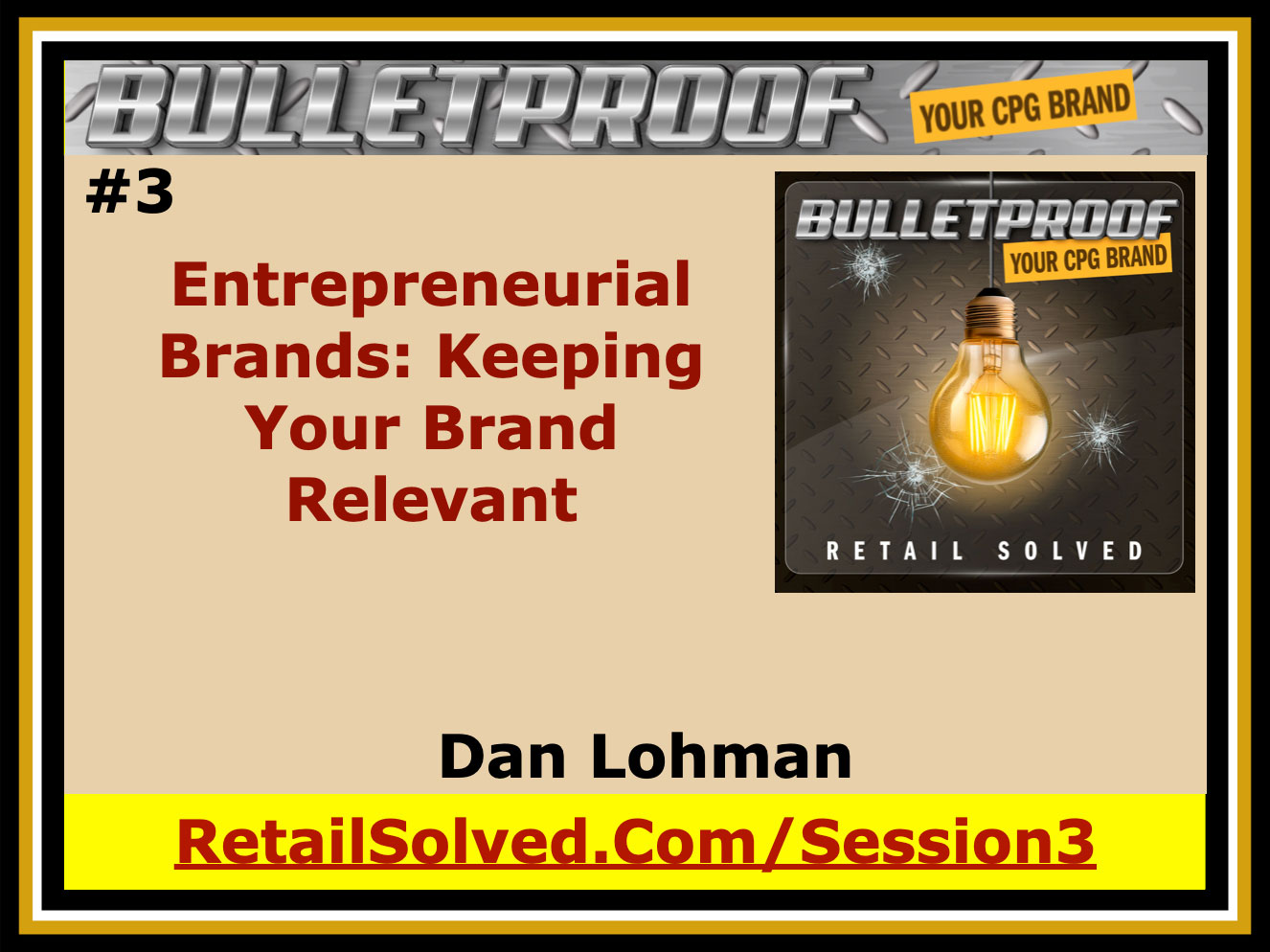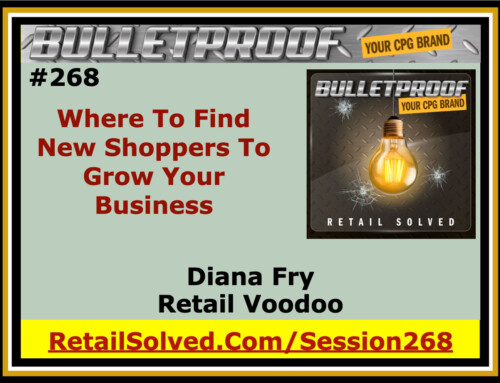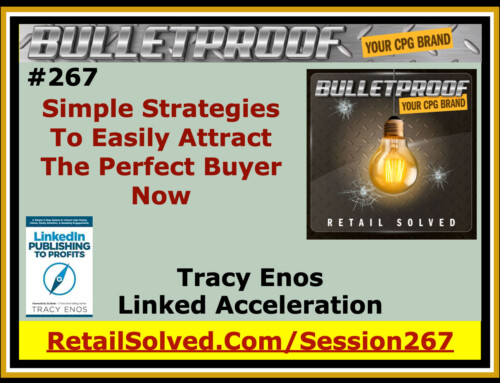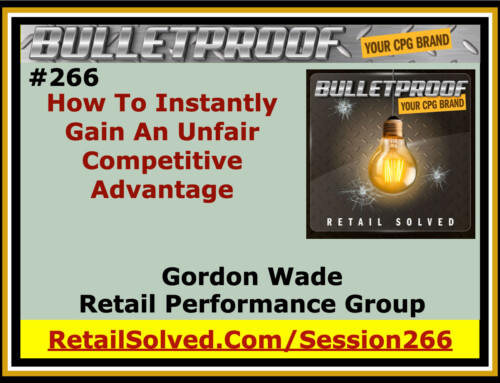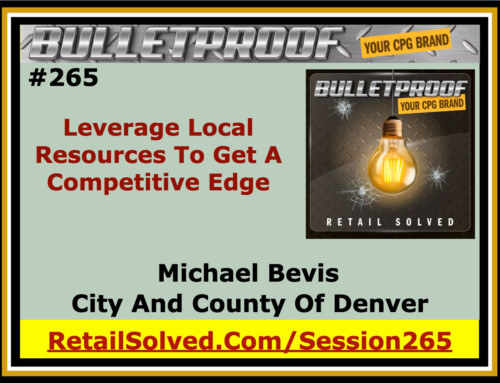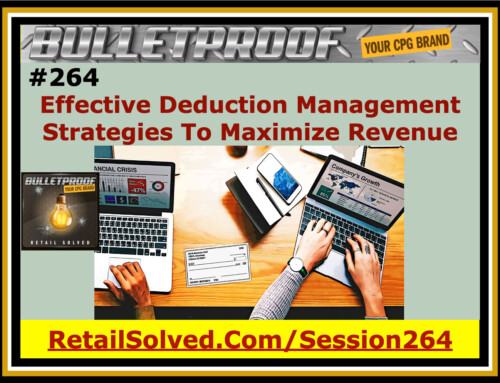Explore strategies for Entrepreneurial Brands to succeed in the competitive market and enhance brand visibility. Key strategies to get your brand on the shelf and keep it there. Become an indispensable resource to retailers help them compete more effectively leveraging your brand. Attract more customers with innovative strategies that put the shopper first.
Hello, thank you for joining me today. Today we are going to talk about the checklist for entrepreneurial brands.
Here are some of the things we are going to talk about:
- how to maximize your relationship with brokers, distributors, and retailers,
- insider secrets, what the big brands know,
- how to tell or create compelling stories for retailers,
- how to identify key opportunities to expand your distribution and improve your merchandise
- why most brands fail and how to avoid the common pitfalls
- actionable insights and brand-building strategies to grow your brand
So, let’s get started. In the last episode, I talked about how natural organic brands are responsible for sustainable growth across every category. That’s important because, in the absence of natural products, most categories are flat or declining. This is the opportunity for natural organic brands to help sell the value of what consumers bring to the mainstream retailers. I also talked about how natural organic products are available across every channel. Mainstream brands rely heavily on Category Management to gross sales. These advanced strategies help them remain competitive, in fact, these advanced strategies and Category Management are responsible for helping them compete more effectively across any channel and across any category.
The opportunity for small natural brands is that big brands typically use a cookie cutter approach to Category Management. This is their Achilles heel. This is where small, agile natural brands can take advantage of these important strategies to gain a significant competitive advantage in the category and with the retailer. This is how natural brands stand out on the self.
Working with brokers and distributors: In a perfect world, a brand would hire a bunch of enthusiastic, passionate ambassadors to help support and grow your brand and to make all of your sales calls. The challenge is, this is very expensive. So how do you maximize your relationship with your retailers and your brokers? Well, several years ago I wrote an article about just this subject. I found that after talking with several natural brands, they had a love-hate relationship with the retailers and brokers. The theme of the article was about how to maximize the relationship by holding them accountable and by using them or leveraging them as your external sales force. So, what does this mean? This means you need to identify who is going to be responsible for what. To not have unrealistic expectations of them. To communicate clearly with them and assume nothing. You need to support them with retail-ready presentations, promotional calendars, new item presentations and merchandising recommendations, etc.
Help your brokers and distributors succeed on your behalf. Remember their success is your success. One of the ways you can do this is by giving them expectations, by using smart goals, hold them accountable and then revisit these goals on frequent interviews and get their buy-in. Make sure they understand exactly what is expected of them. Working with your broker or a distributor can be a huge benefit to your brand’s growth, but only if you work with them in a strategic thoughtful way.
Working with retailers. It never ceases to amaze me how many brands, even big brands, don’t really understand the retailers they serve. They walk into the retailer’s office and say, here is what I need you to do. Here is how I need you to help me grow my sales, instead of the other way around. Becoming an invaluable advocate for the retailer and helping the retailer drive sales within their category.
Download the rest of the show notes below
Listen where you get your podcast
Important: Brand Secrets and Strategies has been rebranded to Retail Solved. Please swap all BrandSecretsandStrategies.com URL’s with RetailSolved.com. This is now the Bulletproof Your Brand podcast. Thank you for listening! BRAND SECRETS AND STRATEGIES PODCAST #3 Checklist for Entrepreneurial Brands Hello and thank you for joining us today. This is the Brand Secrets and Strategies Podcast #3 Welcome to the Brand Secrets and Strategies podcast where the focus is on empowering brands and raising the bar. I’m your host Dan Lohman. This weekly show is dedicated to getting your brand on the shelf and keeping it there. Get ready to learn actionable insights and strategic solutions to grow your brand and save you valuable time and money. LETS ROLL UP OUR SLEEVES AND GET STARTED! Hello, thank you for joining me today. Today we are going to talk about the check list for entrepreneurial brands. Here are some of the things we are going to talk about: how to maximize your relationship with brokers, distributors and retailers insider secrets, what the big brands know how to tell or create compelling stories for retailers how to identify key opportunities to expand your distribution and improve your merchandising why most brands fail and how to avoid the common pitfalls actionable insights and brand-building strategies to grow your brand So, let’s get started. In the last episode, I talked about how natural organic brands are responsible for sustainable growth across every category. That’s important because, in the absence of natural products, most categories are flat or declining. This is the opportunity for natural organic brands to help sell the value of what consumers bring to the mainstream retailers. I also talked about how natural organic products are available across every channel. Mainstream brands rely heavily on Category Management to gross sales. These advanced strategies help them remain competitive, in fact, these advanced strategies and Category Management are responsible for helping them compete more effectively across any channel and across any category. The opportunity for small natural brands is that big brands typically use a cookie cutter approach to Category Management. This is their Achilles heel. This is where small, agile natural brands can take advantage of these important strategies to gain a significant competitive advantage in the category and with the retailer. This is how natural brands stand out on the self. Working with brokers and distributors: In a perfect world, a brand would hire a bunch of enthusiastic, passionate ambassadors to help support and grow your brand and to make all of your sales calls. The challenge is, this is very expensive. So how do you maximize your relationship with your retailers and your brokers? Several years ago I wrote an article about this subject. After talking with several natural brands, they had a love-hate relationship with their retailers and brokers. The theme of the article was about how to maximize the relationship by holding them accountable and by leveraging them as your external sales force. So, what does this mean? This means you need to identify who is going to be responsible for what. To not have unrealistic expectations of them. To communicate clearly with them and assume nothing. You need to support them with retail-ready presentations, promotional calendars, new item presentations and merchandising recommendations, etc. Help your brokers and distributors succeed on your behalf. Remember their success is your success. One of the ways you can do this is by giving them expectations, by using smart goals, hold them accountable and then revisit these goals on frequent interviews and get their buy-in. Make sure they understand exactly what is expected of them. Working with your broker or a distributor can be a huge benefit to your brand’s growth, but only if you work with them in a strategic thoughtful way. Working with retailers. It never ceases to amaze me how many brands, even big brands, don’t really understand the retailers they serve. They walk into the retailer’s office and say, here is what I need you to do. Here is how I need you to help me grow my sales, instead of the other way around. Becoming an invaluable advocate for the retailer and helping the retailer drive sales within their category. When working with the retailer, try to understand the world though their perspective. What are their needs? Their need is for you to become their eyes and ears in the community. They need to understand why consumers shop their competition and what they can do better to keep their shoppers within their store. They need to understand how well they are serving their community, how finicky the retailer is in the eyes of the shopper. Do they align with the claims the retailer makes? They need to know how your product fits within their strategy, they need to know how shoppers perceive the retailer, their assortment and their pricing. This is where you can help the retailer the most. One of the most effective ways to do this is through what they call account penetration. What this means is getting to know on a personal level, all the people you come in contact with. The people who do the shipping, the logistics, the paperwork, etc. Get to know them on a level where you can help support their needs individually. What I mean by this is don’t put the burden entirely on the buyer’s shoulders. Also work with the people who do the schematics and the merchandising. Make sure they understand where your products go on the shelf, how to best merchandise it and why that is important. Work with the logistics people, help them understand how to get your product into the store. Make it easy for them. The more you do to help the retailer with all levels of communication the more it is going to help you in the long run. Again, the biggest challenge that retailers have is that a lot of brands show up and say, ‘have I got a deal for you today’. What a retailer would much rather hear is, what can I do to help support you, how can I help drive sales in your category and how can I help to make your life easier. The sad reality is that most selling opportunities are squandered. Retailer appointments are more than an opportunity to talk to retailers. Every appointment needs to be collaborative, serving each other’s needs. Every appointment needs to be an opportunity to educate and build value. Remember, you are far more than just your brand. Be indispensable, you need to have a retailer’s checklist. Be prepared, know your numbers, how are your sales, how is your competition’s sales. Know your competition, be an expert in their brand. Know the market and how well the retailer is performing within the market. Become the retailer’s eyes and ears. What are the category trends, who is the core consumer? How do they make decisions and what do they need and want? Help the retailer answer these important questions and more importantly, help the retailer understand why your brand stands out on the shelf and why your brand is going to help them grow sales. This is where you have a unique opportunity to help the retailer understand how your product is going to help them solve their problem. Their problem is growing sales in the category and increasing foot traffic in the store. Remember, be indispensable, this is how you set yourself apart from your competition. So, how do you do this? Every presentation must include a category review, even a basic category review. Include insights, category trends and market trends. Include pricing and promotion overview and insights. How does the retailer compare to the competition? Include an assortment of recommendations, does the retailer miss sales by not having the right assortment on their shelves? Include merchandising recommendations. Is the category easy to shop and consumer friendly? Offer information about new products and ingredients. Every presentation should also include consumer shopper insights. These are the insights about the consumer, how they shop the category, why they make the decisions they do, etc. Always include market basket insights. Remember, market basket is what is in the basket when the consumer buys your product at checkout. This is your opportunity to highlight to the retailer how important your consumer is them, and how to nurture that retailer to continue to drive sales in their store. Education, I cannot stress this enough. Your presentation should include some element of education. This is how you become indispensable, this is how you develop a relationship with the retailer where you become category leader, their go-to person to help them drive sales in their category. This should be the goal of every brand, more importantly, this is how a small brand can become an indispensable resource to the retailer. Consumers are confused. Here is another opportunity where a small natural brand can help a retailer to better educate their consumer. So, what do I mean by this? When I speak in front of groups of retailers, brokers and distributors and brands, I typically ask the question, what does natural mean to you, what does non-GMO mean, what does organic mean, what does clean label mean and which one is best? I am always surprised by the answer. I find that retailers, brokers, and distributors and sometimes even the brands can’t always answer these. Well, if we can’t answer the question, then how is the consumer going to know understand what is better for you. Here are the answers to those important questions. Natural is a term that really has no meaning, it is a term that we use genetically to understand or to define the category. Non-GMO, simply means that the seed used to produce the crop was non-genetically modified. Non-GMO, however, does not mean that the soil, the crop was grown in was free of pesticides and herbicides. So, what does organic mean? Organic means that the product does not have any pesticides, it is automatically non-GMO and there were no herbicides used. A certified organic product is the cleanest product you can buy. While the definition for the term clean label is up for debate, generically what clean label means is that it is free of GMO’s, allergens, pesticides and herbicides. So, what does the core natural shopper look like and why does it matter? A lot of people, a lot of brands and a lot of retailers seem to think that consumers are only motivated by price. In other words, price is the only thing that drives us to the shelf. This is simply not true. Have you ever received a really great deal on something that you didn’t like, something that didn’t meet your needs? Natural consumers want quality over price. Committed natural consumers don’t settle for products that don’t meet their nutritional needs. This is what differentiates the core natural consumer over other consumers and this is why they are so valuable to the retailer and to your brand. I would like to switch gears now and talk about how to use these advanced strategies and how to make them work for your brand. But first let me give you a brief history of how these advanced strategies came about. Natural today is very similar to the way mainstream was 20 to 30 years ago. What I am referring to is the go-to market strategy that mainstream brands used to get their product on the shelves. A lot of the inefficiencies that you see in natural today existed in mainstream. We had distributors we had to work with to get our products on the shelf, then we had to call on each and every individual store. This, of course, added a lot of cost to the products. The big change came when retailers started to develop their own distribution centers. This helped reduced some of the costs because the manufacturer could drop the product off at the retailer and then the retailer would put it on the shelf. This allowed the brands to save a tremendous amount of money and reduce their head count. The mainstream retailers took care of everything, putting the product on the shelf, making sure the signage was OK. The product was reordered when it was needed to be and the promotions were handled by the headquarters office. One of the key drivers for this advantage for this advanced strategy was Category Management. Category Management was a game changer when it came to making sure the retailers had the right product on their shelf, that inventories were managed effectively, that promotions delivered value back to their consumer and for the brand and it helped to lower the cost of goods to the end consumer. So, what is Category Management? Category Management is both the art and the science of getting your product into the hands of the shoppers. True Category Management is the great equalizer between small brands and their more sophisticated counterparts. I coined the term true Category Management to differentiate between the cookie cutter methods that most mainstream brands use. Let me explain. Nothing happens until someone buys your product and shoppers can’t buy what they can’t find. The path to sustainable sales is to get your product in the hands of more shoppers. It is critical to increase sustainable food production in sales. It is the key to more organic farming, healthier product innovation, reducing obesity and food allergies and supporting a food echo system that is sustainable beyond tomorrow. Nowhere is this truer than in natural. The competitive landscape is changing and the old strategies are simply not enough. Natural brands and retailers need to become more strategic. This does not mean compromising on their principles, on the contrary. This is their strength and their principle should be at the heart of every strategy. This means focusing on the value they create and leveraging it at retail and with consumers. Consumers are willing to pay a premium for quality healthy products. Healthy products are responsible for most of the growth across every category and across every channel. True Category Management differentiates itself because it really focuses on who this core consumer is. Leveraging the best strategies to help connect the end consumer, the core natural consumer, with the products they want and need to buy. So why does this matter? This matters because it increases distribution of preferential merchandising. It helps turn the average shopper into a loyal shopper. Shoppers know what they want, shoppers want convenience. It also helps maximize trade spending, helps to maximize your promotion, your category leadership and it helps increase sales and profit. Here is the checklist I promised to help you make the most of these advanced strategies. Know your retail partner What are your retailer’s goals and objective for the category? What role does the category play on the retailers? Does the category drive traffic, profit etc. for the retailer? What strategies, tactics and roles does the retailer have for the category? What are the new item and category guidelines or rules? What does the retailer expect from his vendors or manufacturers? Does the retailer have a category review template? Do they welcome additional insights? How knowledgeable is the retailer in your category and your brand? Retailer penetration: Who are the key contacts you need to know? What are their duties and how do you interact with them? Who is your champion, find one and develop one with them? Who are the retailer’s competitors? Who are your competitors? How do the top brands merchandise and promote their product? What is the category definition? From the retailer’s perspective, how does the shopper define the category? From the consumer’s perspective, how does the shopper define the category? This is really important, this is going back to the information we talked about earlier. This is where retailers need your help, they want to know what motivates the consumer to choose one item over another item. When a consumer buys one item, what other items would you expect to find in their shopping basket? Do the retailer’s and the consumer’s perceptions match up? This is typically the first-place brands can help educate retailers about their shoppers and the opportunity to help them grow sustainable sales. This is where brands can differentiate themselves and establish themselves as an indispensable, important and a strategic resource. What is the shopper’s decision-making process? How do they make product selections in your category? What do they choose first, second and third? For example, do they choose color first, size first, price, etc.? Who is the core, primary, category shopper? Who purchases the category, are they men, are they female, are they a parent, are they a student? What level of education do they have? What characteristics does the primary shopper have? Why do they shop the category and what needs are they trying to satisfy? These are the questions that every brand needs to know. Answering these simple questions is going to help you help the retailer sell more products, increase shopper traffic into their stores, develop loyal happy customers and to help them compete effectively in their market. So, here are some of the things we have talked about. We talked about maximizing your relationship with brokers, distributors and retailers. Remember, their success is your success. Insight secrets, we talked about what the big brands do and what they know. What they know is how to leverage these advanced strategies, Category Management, to grow sales and to help their retail partners compete more effectively. We talked about creating a compelling sales story for retailers by utilizing these advanced strategies. This is how you stand out on the crowded shelf. This is how you become the category leader. In the process of becoming a category leader you are going to identify key opportunities to expand your distribution and improve your merchandizing. The goal is to make it easier for the consumer to find your product on the crowded shelf. One of the key reasons that most brands fail is because they simply don’t know what they don’t know. Sometimes this includes hiring the wrong resources to help support them. Sometimes this includes not being involved enough in their business and understanding what is really driving sales. I believe that knowledge really is power, especially in this situation. Understanding these key concepts is going to help you build a strong foundation that is going to support your brand’s growth well into the future. True Category Management is the foundation of advanced strategies that produces actual insights and brand strategies to grow your brand. We are going to be covering a lot more of these strategies in later episodes. I’d like to get your opinion and your feedback. I’d like to understand what specific topics that you would like me to cover. Remember that this show is about you and it is for you. Let me know how I can best serve you, by emailing me and letting me know what topics you want me to cover. The gift that I have for you today is a guide that I wrote, called ‘Strategic solutions to grow your brand’. It outlines the core fundamentals of true Category Management. Text ‘strategicsolutions’ to 44222 to download your free copy. As always, you can go to brandsecretsandstrategies.com/session3. To download the show notes and to gain access to all of these resources and more. This episode's FREE downloadable guide This short guide levels the playing field between small brands and their more sophisticated competitors. It highlights the advanced strategies the big brands use called Category Management - what retailers want. CLICK HERE TO DOWNLOAD YOUR FREE STRATEGIC GUIDE: Strategic Solutions To Grow Your Brand Thanks again for joining us today. Make sure to stop over at brandsecretsandstrategies.com for the show notes along with more great brand building articles and resources. Please subscribe to the podcast, leave a review, and recommend it to your friends and colleagues. Sign up today on my website so you don’t miss out on actionable insights and strategic solutions to grow your brand and save you valuable time and money. I appreciate all the positive feedback. Keep your suggestions coming. Until next time, this is Dan Lohman with Brand Secrets and Strategies where the focus is on empowering brands and raising the bar.
Enter your name and email address below and I'll send you periodic brand building advice, tips and strategies.
Sign up to receive email updates
FREE Trade Promotion ROI Calculator:
Click Here To Maximize Sales And Profits
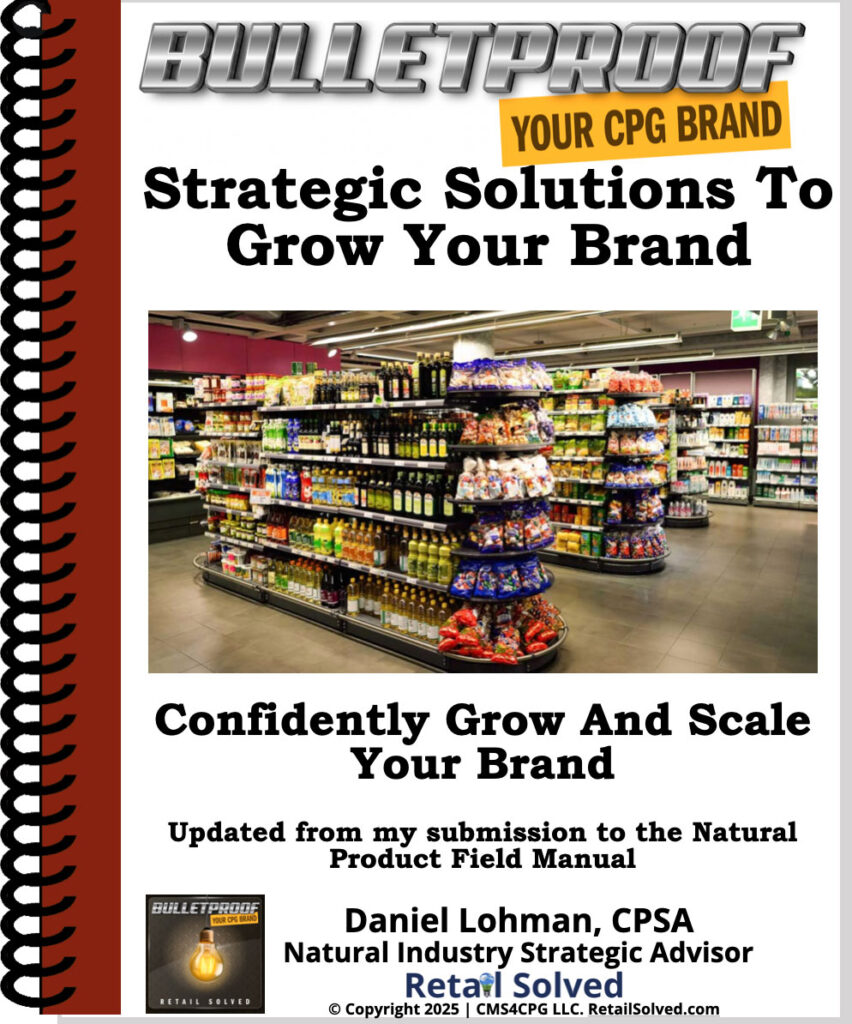
Need Strategic Solutions To Grow Your Brand?
Category Management empowers brands to maximize success through data-driven insights and fact-based selling. Get the comprehensive overview of the advanced tactics and strategies big brands rely on. This guide will level the playing field for your brand by providing actionable insights and strategies to grow sales and profits – what retailers REALLY want! Updated from my submission to the Natural Products Field Manual.
Image is the property of CMS4CPG LLC, distribution or reproduction is expressively prohibited.
